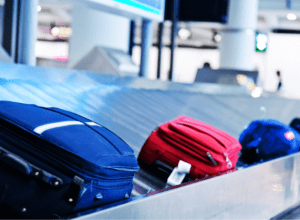I have 20 hacks to prevent baggage theft and help you minimize your exposure to loss at the airport.

The missing items included Gucci pants, a gold bracelet, a real Louis Vuitton bag and a $5,700 Rolex. I have sympathy for any theft victim, but who would think it’s actually safe or smart to pack belongings that are so obviously valuable as a Louis Vuitton bag and a Rolex in their checked luggage?
Early last month, two TSA (Transportation Security Administration) agents were accused of stealing from passengers at Miami International Airport. The Florida State Attorney’s office released video clips showing the thefts. Government agents are supposed to protect us, not steal from us, but passengers can’t take that for granted.
Every traveler must take responsibility for protecting their luggage and belongings from theft.

I’ve got real-world hacks to prevent baggage theft or merely having your checked luggage go missing when you fly. These hacks will prevent theft from your carry-on when it’s out of your custody at airport security.
Leave it at home if you can’t afford to lose something and don’t need it for your journey.
1. Leave it at home if you can’t afford to lose it, whether for its financial or intrinsic value.
2. If you really don’t need it on your journey, leave it at home.
3. Never wear or bring flashy or expensive jewelry while traveling. Their appearance advertises and loudly state wealth and screams, “Please steal me.”
Valuables, breakables and essentials should always be packed in your carry-on, not your checked luggage.
4. Never pack valuables and breakables in your checked luggage. If your valuables and breakables are lost, stolen or damaged, you won’t be able to get compensation from your airline, as the airlines exempt themselves from liability for their loss. Moreover, the airline’s limit of liability domestically in the U.S. is $3,800, and internationally, just $1,700. The Spirit Airlines passenger described above could only get $1,700 compensation for her $10,000 loss, just 17 percent of their value.
5. Valuables and breakables should only be carried by each traveler directly or in their carry-on bag or personal item. All essential belongings such as medications, both over-the-counter and prescription, should be packed in travelers’ carry-on bags. If it’s essential for your journey, it should never be packed in your checked luggage because it’s much more likely to be lost, delayed or stolen than your carry-on bag or personal item.
6. Skip approved “TSA” locks for your luggage. They’re not worth their purchase price as they are easily defeated. You can get schematics for a complete set of working TSA master keys for free on the internet. All you need is a 3D printer to make them. Instead of the locks, I’ve used numbered plastic tamper seals that can’t be resealed once broken. That way, I’ll know if my bag has been opened to alert me to check its contents carefully.
7. Avoid luggage with zippers when you purchase your next bag(s). It’s too easy to penetrate zippers with a simple tool or even a ballpoint pen. Buy a hard-sided bag with some latch locking.
Personalize your luggage so you can identify them quickly and easily.
8. Personalize your luggage for easy identification and to differentiate your bags from everyone else’s to make it harder for thieves to say they thought it was theirs and get away with continued thievery. I use a colorful belt on each of our bags, plus a heavy-duty ribbon on the top handle and personalized ID tags on each handle on each piece of luggage.
9. Photograph your belongings in your bag as you pack them for proof they were packed.
10. If possible, avoid checked luggage altogether.
11. Book flights using a credit card that offers insurance for lost, stolen or damaged luggage.
Use an Apple AirTag or equivalent to track your luggage or gate-checked carry-on.
12. Put an Apple AirTag or its equivalent in your checked luggage and carry-on item so you can track its location to help find it, if necessary. Put it in your carry-on if you must gate-check it for any reason.
13. If you fly domestically, enroll in TSA Pre-Check. While at TSA security checkpoints in the U.S. you’ll be better able to stay close to your bags and belongings as they move through security.
14. If you fly internationally, enroll in Customs and Border Protection’s Global Entry. First, it will give you TSA Pre-Check privileges and second, it will allow you to typically get to baggage claim in the customs area at U.S. airports upon your return to the U.S. before the luggage appears, so you can prevent someone else from grabbing your bag and/or its belongings when it appears on the carousel.
15. Before leaving home, tag any of your belongings with your identification that will be placed in a security checkpoint bin, including your carry-on, personal item, laptop, electronic devices, etc., so you can easily point to them and say, “That’s mine.”
Never put any valuable belongings loose in a bin at airport security because it’s too easy to steal from the bin when stowed that way.
16. At airport security checkpoints, never put your cell phone, wallet, keys, cash, etc., loose in a security bin. Put them inside your carry-on or personal item in a zippered bag, not in an outside pocket, or at the least in a zippered pocket in a jacket or other piece of clothing in a bin.
17. At airport security checkpoints, never enter the metal detector or full body scanner until your last carry-on item enters the carry-on x-ray scanner. If you only pass through a metal detector, you should be at the carry-on x-ray scanner exit as your belongings appear. Be sure you’re carrying nothing in your pockets that would require a rescan, so you won’t be able to be at the scanner exit when your belongings get there.
18. At airport security checkpoints, if your belongings are pulled for secondary screening, insist that you can watch it.
When you land, go directly to baggage claim so you’re there before the bags appear to prevent their theft from the luggage carousel.
19. When your plane lands, go directly to baggage claim as quickly as possible unless you’ve gate-checked a bag. If you have, wait for it, then immediately go to baggage claim. Don’t stop at a lavatory on the way. Use one in the baggage claim area after you get your bag(s). It’s best to arrive at the luggage carousel before your flight’s luggage appears to prevent its theft from the carousel.
20. Position yourself near enough to the carousel’s luggage entry point to see it until you take possession of it.

Read also–
Social media influencers must disclose paid posts
12 traveler wildlife viewing rules crucial for the natural world
After many years working in corporate America as a chemical engineer, executive and eventually CFO of a multinational manufacturer, Ned founded a tech consulting company and later restarted NSL Photography, his photography business. Before entering the corporate world, Ned worked as a Public Health Engineer for the Philadelphia Department of Public Health. As a well known corporate, travel and wildlife photographer, Ned travels the world writing about travel and photography, as well as running photography workshops, seminars and photowalks. Visit Ned’s Photography Blog and Galleries.



